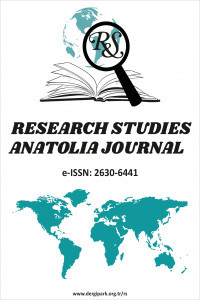GÖÇÜN ENTELEKTÜEL SERMAYENİN HAREKETLERİNE ETKİSİ: İLLERE GÖRE GÖÇ VE PATENT SAYISI ARASINDAKİ İLİŞKİNİN BELİRLENMESİ
Göç, Entelektüel Sermaye, Patent
The Effect of Migration on the Intellectual Capital: Determination of the Relationship Between Migration and Patents
Migration, Intellectual Capital, Patents,
___
- Abeysekera, I. (2007). "Intellectual Capital Reporting Between a Developing and Developed Nation", Journal of Intellectual Capital, Vol. 8 Iss 2 pp. 329 – 345.
- Aksu, L. (2015). “Türkiye’de Beşeri Sermayenin Önemi: Ekonomik, Sosyal ve Stratejik Analizi”, Akademik Araştırmalar Dergisi, 17(66), ss. 41-88.
- Cleary, P. & Quinn, M. (2016). “Intellectual Capital And Business Performance an Exploratory Study of the Impact of Cloud-Based Accounting and Finance Infrastructure", Journal of Intellectual Capital, Vol. 17 Iss 2 pp. 255 – 278.
- Demir, Ö. (2005). “Entelektüel Sermayenin İşletmelerin Piyasa Değerlerine Olan Etkisi”, Doğu Anadolu Bölgesi Araştırmaları, 3(2), ss. 77-82.
- Housel, T. J. & Nelson, S. K. (2005). “Knowledge Valuation Analysis: Applications for Organizational Intellectual Capital", Journal of Intellectual Capital, Vol. 6 Iss 4 pp. 544 – 557.
- Kendirli, S. & Diker, F. (2016). “Kâğıt ve Ambalaj Sanayi İşletmelerinde Entelektüel Sermayenin Finansal Performansa Etkisi”, Muhasebe ve Vergi Uygulamaları Dergisi, 9(1), ss. 45-58.
- Koçak, O. & Uygun, B. (2011). “Entelektüel Sermayenin Temel Unsurları: Altın Yakalılar”, Uluslararası 9. Bilgi, Ekonomi ve Yönetim Kongresi, 23-25 Haziran 2011, Saray Bosna, Bosna Hersek.
- Nerdrum, L. & Erikson, T. (2001). "Intellectual Capital: A Human Capital Perspective", Journal of Intellectual Capital, Vol. 2 Iss 2 pp. 127 – 135.
- Pazarcık, S. F. (2010). “Beyin Göçü Olgusu ve Amerika Birleşik Devletleri Üniversitelerinde Çalışan Türk Sosyal Bilimciler Üzerine Bir Araştırma”, Çanakkale Onsekiz Mart Üniversitesi Sosyal Bilimler Enstitüsü Çalışma Ekonomisi ve Endüstri İlişkileri Anabilim Dalı, Yüksek Lisans Tezi, s. 165.
- Roos, G. & O'Connor, A. (2015). “Government Policy Implications of Intellectual Capital: An Australian Manufacturing Case Study”, Journal of Intellectual Capital, Vol. 16 Iss 2 pp. 364 – 389.
- Roos, G.; Bainbridge, A. & Jacobsen, K. (2001). “Intellectual Capital Analysis as a Strategic Tool", Strategy & Leadership, Vol. 29 Iss 4 pp. 21 – 26.
- Tomé, E. (2004). “Intellectual Capital, Social Policy, Economic Development and the World Evolution", Journal of Intellectual Capital, Vol. 5 Iss 4 pp. 648 – 665.
- TPE, (2017). “İllere Göre Patent Başvuruları”, http://www.turkpatent.gov.tr/TurkPatent/statistics.
- TÜİK, “İllere Göre Göç İstatistikleri”, http://www.tuik.gov.tr.
- Yayın Aralığı: Yılda 4 Sayı
- Başlangıç: 2018
- Yayıncı: Arif YILDIZ
EKONOMİK KRİZ DÖNEMLERİNDE TAM ZAMANINDA ÜRETİM (JUST IN TIME) SİSTEMİNİN UYGULANMASI
Gülferah ERTÜRKMEN, İsmet BOLAT
TÜRKİYE’DE YOKSULLUKLA MÜCADELE POLİTİKALARININ HUKUKİ ÇERÇEVESİ
CAMERON-QUINN ÖRGÜT KÜLTÜRÜ TİPLERİ İLE YENİLİKÇİLİK ARASINDAKİ İLİŞKİNİN İNCELENMESİ
Esra KAYIŞ, Murat GÜRKAN GÜLCAN
BRUNO ETİENNE’İN DÜŞÜNCESİNDE BATI VE MÜSLÜMAN TOPLUMLAR
Arif Selim EREN, Ali Haluk PINAR, Mesut BİLGİNER
GARANTİ MARKALARINDAN DOĞAN SORUMLULUĞUN SİGORTALANMASI
